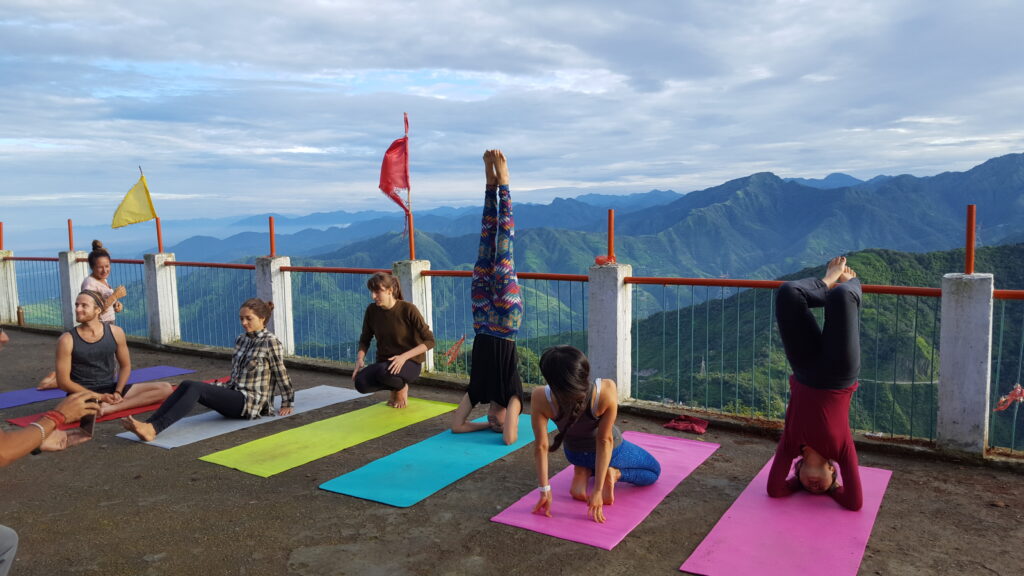Yoga or more Precisely Yog, as a word, is derived from the Sanskrit root ‘Yuj’, which means to combine, Yoke or join. This is one of the Six Primary schools of Indian philosophy established to further propagate and elaborate the teachings of the Vedas. Vedas or Ved, as we call them, are the most revered compilation of knowledge and revelations in the Indian subcontinent. They are the pillars of the Vedic civilisation which has existed now for the longest amount of time. The dates however, are not a subject matter of discussion here so we will not go into those details. There are four Vedas:
- Rig Ved
- Yajur Ved
- Atharva Ved
- Sam Ved

Contrary to the popular beliefs, Vedas are not scriptures or books, rather they are a series of compiled wisdom about various aspects of life and universe, by numerous scholars, who are known as Rishis, in the Indian tradition. They were not written, rather revealed and recorded in a continuum. The timeline of Vedas is expansive. We will have to write another article to explain the same. The world view of Vedas is that of a cyclical course rather than a linear motion. And that’s what makes establishing timelines more difficult.
However, under the Vedic system, the Six Schools of Philosophical expositions and methods were established, so that the subjects and topics can be streamlined and studied sincerely. The scholars of Vedas were known as Brahmcharis or Vedpathis. To mention the names they are:
- Nyaya
- Vaisheshik
- Sankhya
- Yoga
- Mimansa
- Vedant
These six schools are primarily concerned with the study of Atma Tattva, the consciousness. Considering this universe as a coalition of various elements from physical to non physical, the different schools propounds formulas to understand and experience the supreme element which is Atma itself. In its most classical parlance, yoga stands out to be a method of realising the real self. Once this realisation happens, a person becomes free of the binding elements and is known as a Yogi.
This system of Yoga is popularly known as Ashtanga Yoga or the Eight limbed Yoga of Maharishi Patanjali. A much revered and honoured Rishi, Patanjali stands out to be the father of yoga. His system is considered as one of the benchmarks in the study of human consciousness and is the basis of most of the modern day eastern philosophies. The work is known as the Yoga Sutras of Patanjali. Sutra means a thread, but here it refers to a concise statement. He crafted 185 sutras in his work, to explain the nature and workings of human mind & conciousness, its causes and effects, the mind body connections, the Self and also elaborates the various states in which mind can exist. To most of the yoga practitioners, yoga sutras are something as a guiding light.

Keeping this article limited to the Patanjali’s Yoga Sutras, I would like to elaborate the subject matter. The Ashtanga Yoga of Patanjali, as its popularly known as, is a stupendous work on explaining scientifically, the working of human psyche and how to control and navigate the mind in order to obtain a fulfilling life experience. Patanjali has very categorically explained various faculties of psyche and has given us an eight fold path to overcome the base tendencies of mind and harness the higher faculties. The eight steps of Ashtanga Yoga are:
Steps Of Yoga
- Yama
- Niyama
- Asana
- Pranayama
- Pratyaharato
- Dharana
- Dhyana
- Samadhi
These eight steps are like ladders to build a lifestyle which is conducive to the correct development of a human being in all the aspects of life. Body, Mind and Spirit. They leads a person from the base level of conscious functioning to accessing higher faculties of mind and eventually in the culmination of a supra conscious state of absolute self experience. Patanjali has been very accurate and pragmatic in handling the problem associated with life and has provided a method which is supposedly the ultimate release of bondages of Avidya (absence of knowledge), Asmita (ego perception), Raag (indulgence), Dwesh (aversions) and Abhinivesh (fear). As these limiting constraints of human psyche are removed, the true knowledge appears just like the sun shines out when clouds are removed. Clouds do not vanish the sunlight completely; rather they just block it to reach to us for some time. As soon as they fade out the sun shine returns back in its full bloom.
Avidya: Avidya (A+Vidya) literally means ignorance. In the Vedic tradition this is a state of absence of knowledge which is referred by many different names. Mistaking the transient for the permanent, the impure for the pure, pain for pleasure, and that which is not the self for the self. This state is natural to the living beings as a characteristic of individual consciousness. In the yogic psychology, Avidya is considered to be the seed for subsequent effects that reflects as sufferings in life. The goal of education, as per the vedic teachings, is the culmination of Vidya i.e. knowledge of the real, which eventually leads to the removal of the factors responsible for bringing up an experience of suffering.
Asmita: Asmita is the effect of Avidya. It refers to the individual ego or the feeling of I-ness which identifies the seer with the instrument of cognition. Yogic psychology states that ego is the binding factor between Atma (Self) and Buddhi (Instrument of cognition). Under the effect of Asmita, the seer identifies itself with the object of experience and a duality of experience is cultivated known as Sukha (pleasure) and Dukha (pain).
Raag: Raag is the emotional attachment created by the desire to be attached to Sukha or Pleasure. As the ego gets fixated on pleasure, the desire for continuation and attachment to the pleasure emerge.
Dwesh: the opposite polarity or repulsion or hatred is Dwesh. That which is not favourable to Ego, it triggers an emotional reaction of hatred or aversion.
Abhinivesh: is the innate fear of losing the objects of cognition. This is a reflected as the instinctual attachment to life or self preservation. Found universally in all beings it is the subtle characteristic as fear of death.






